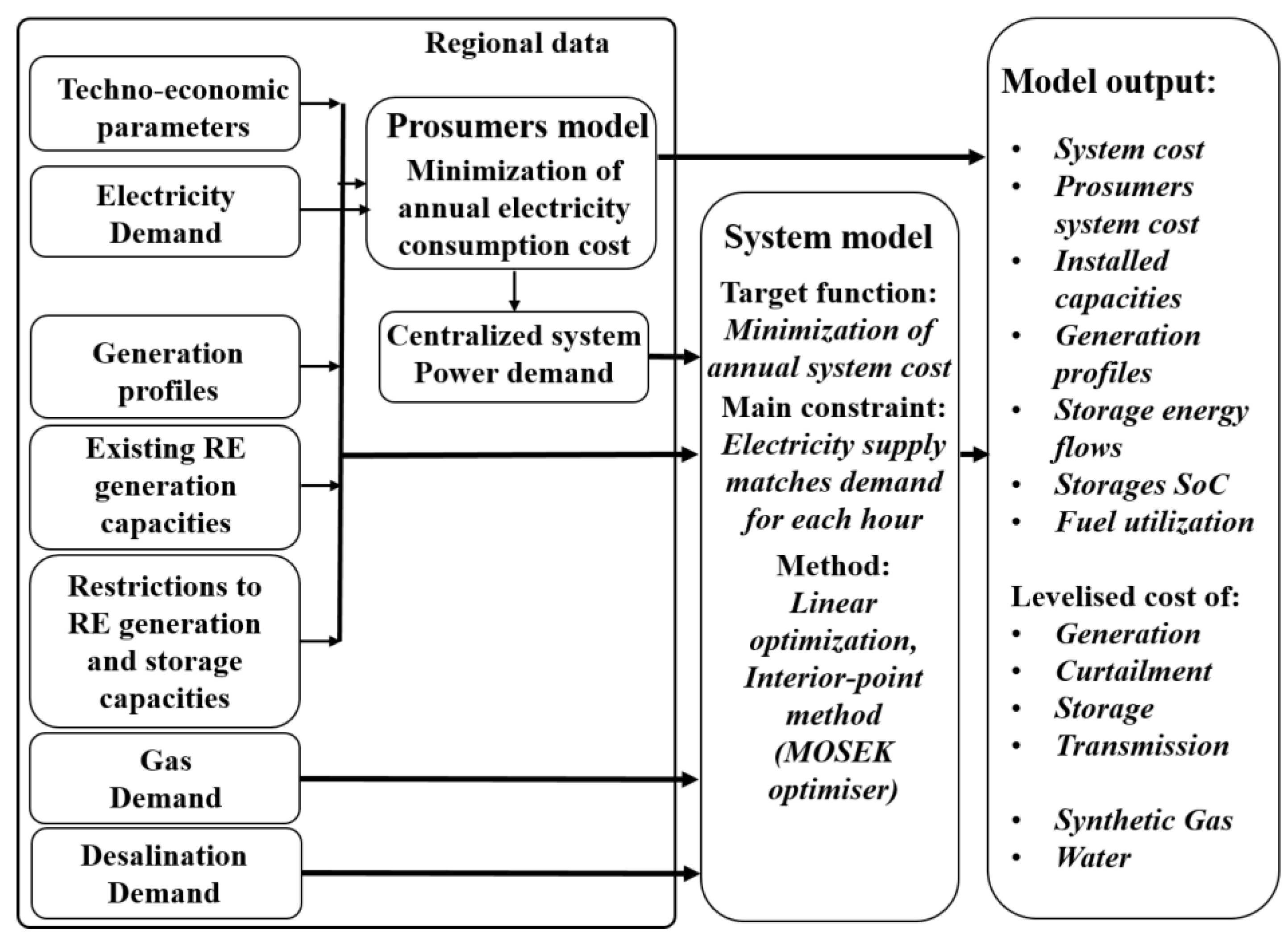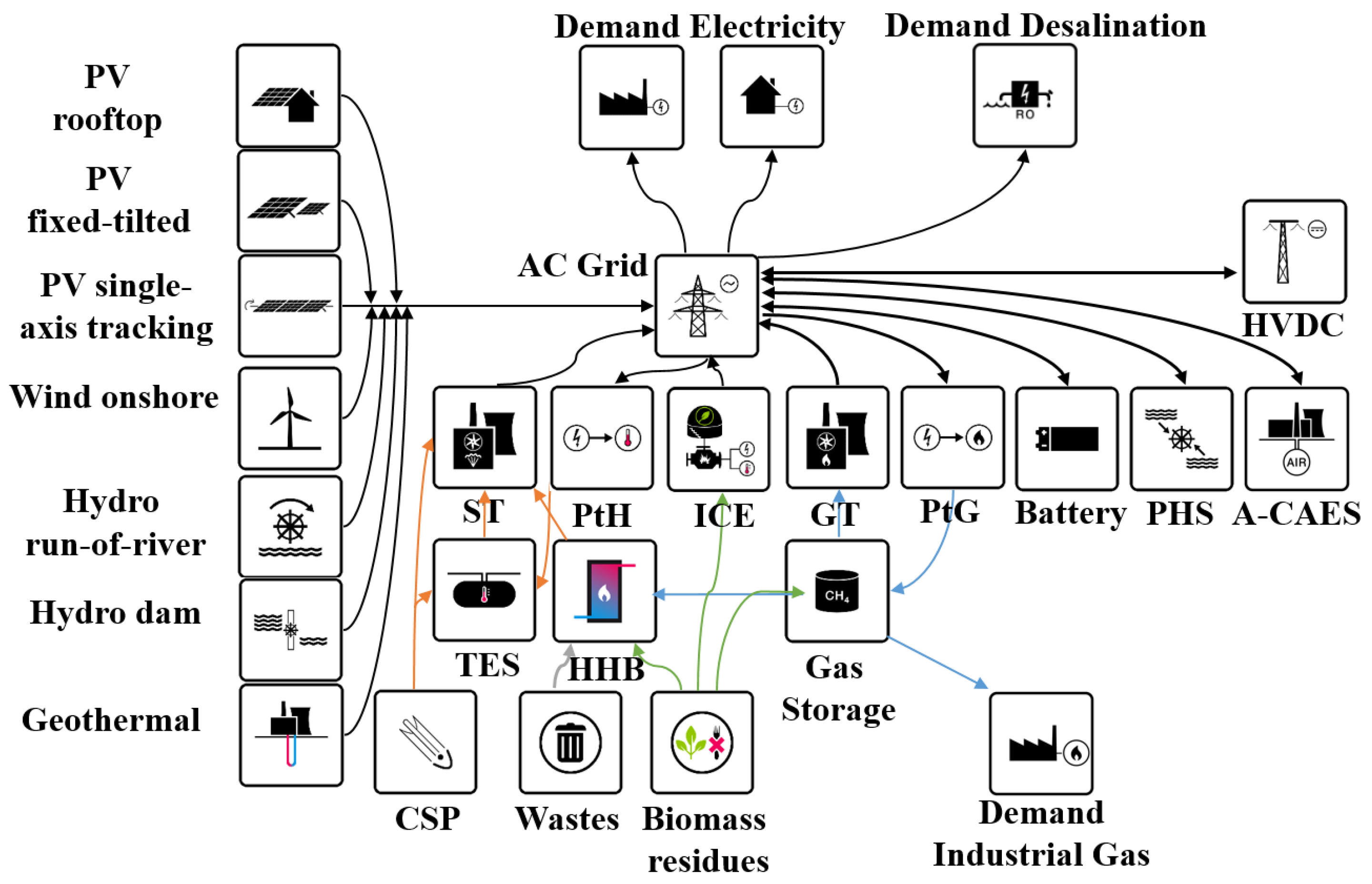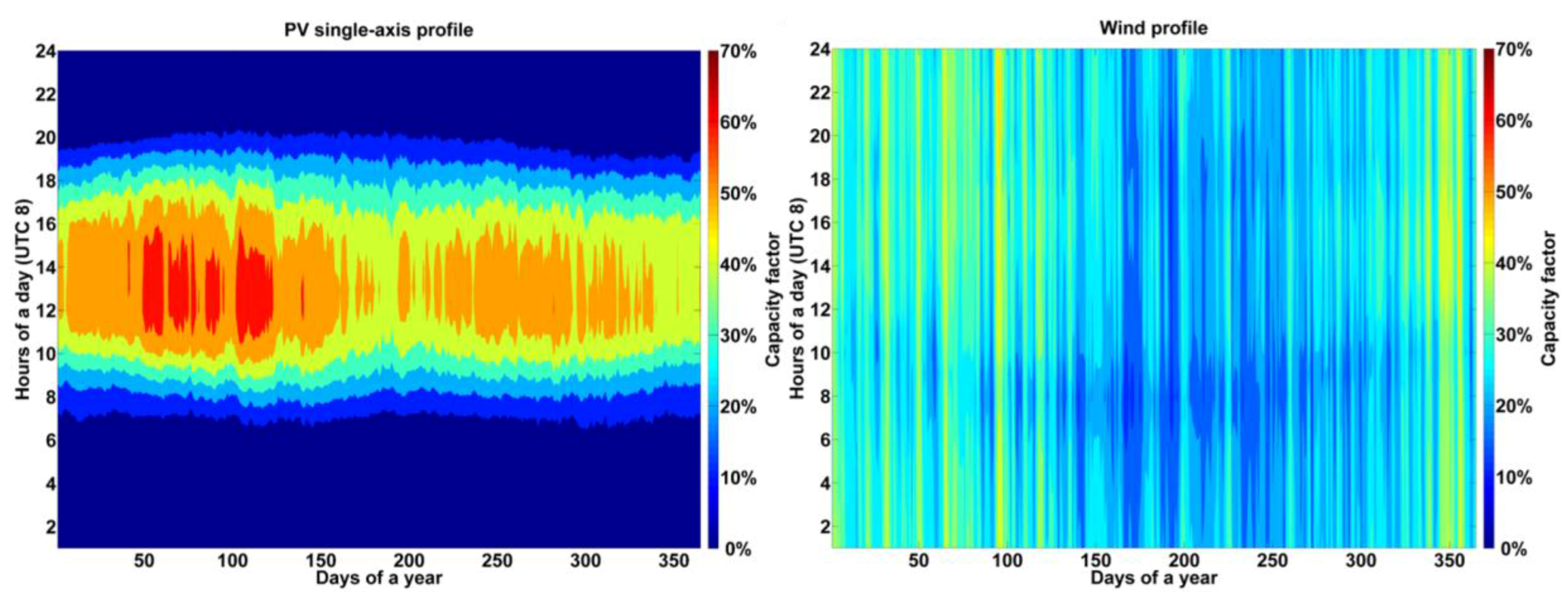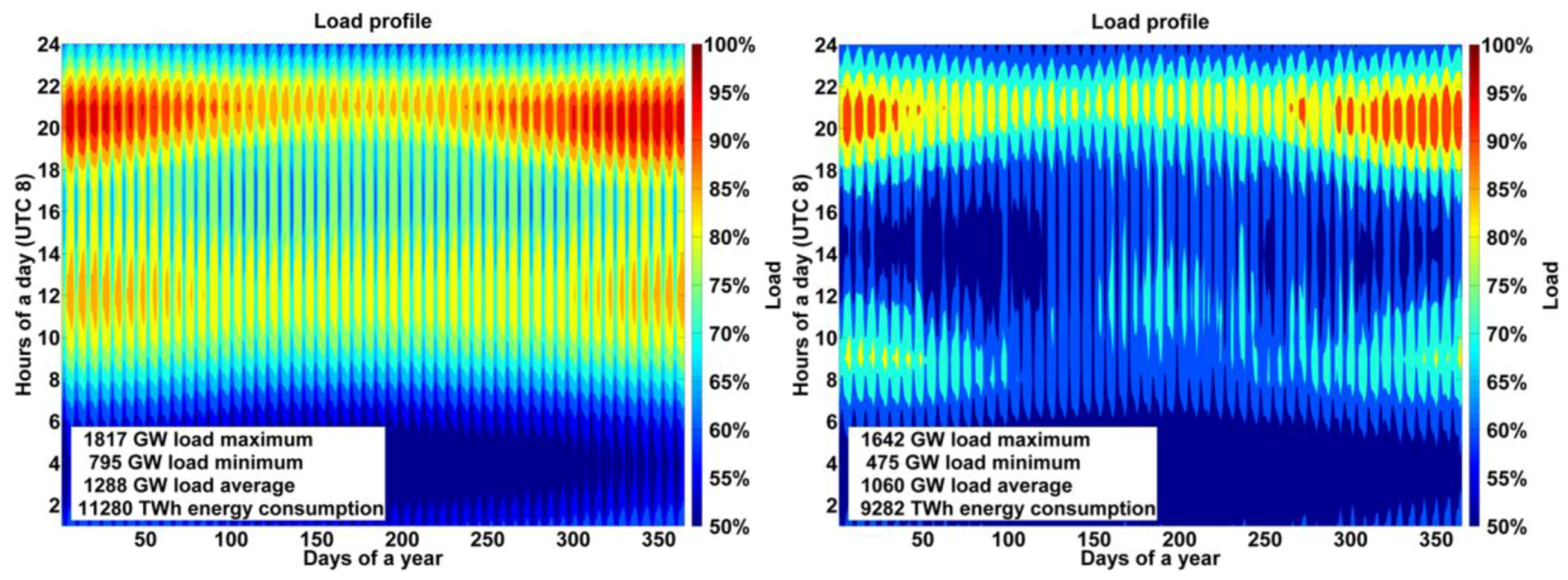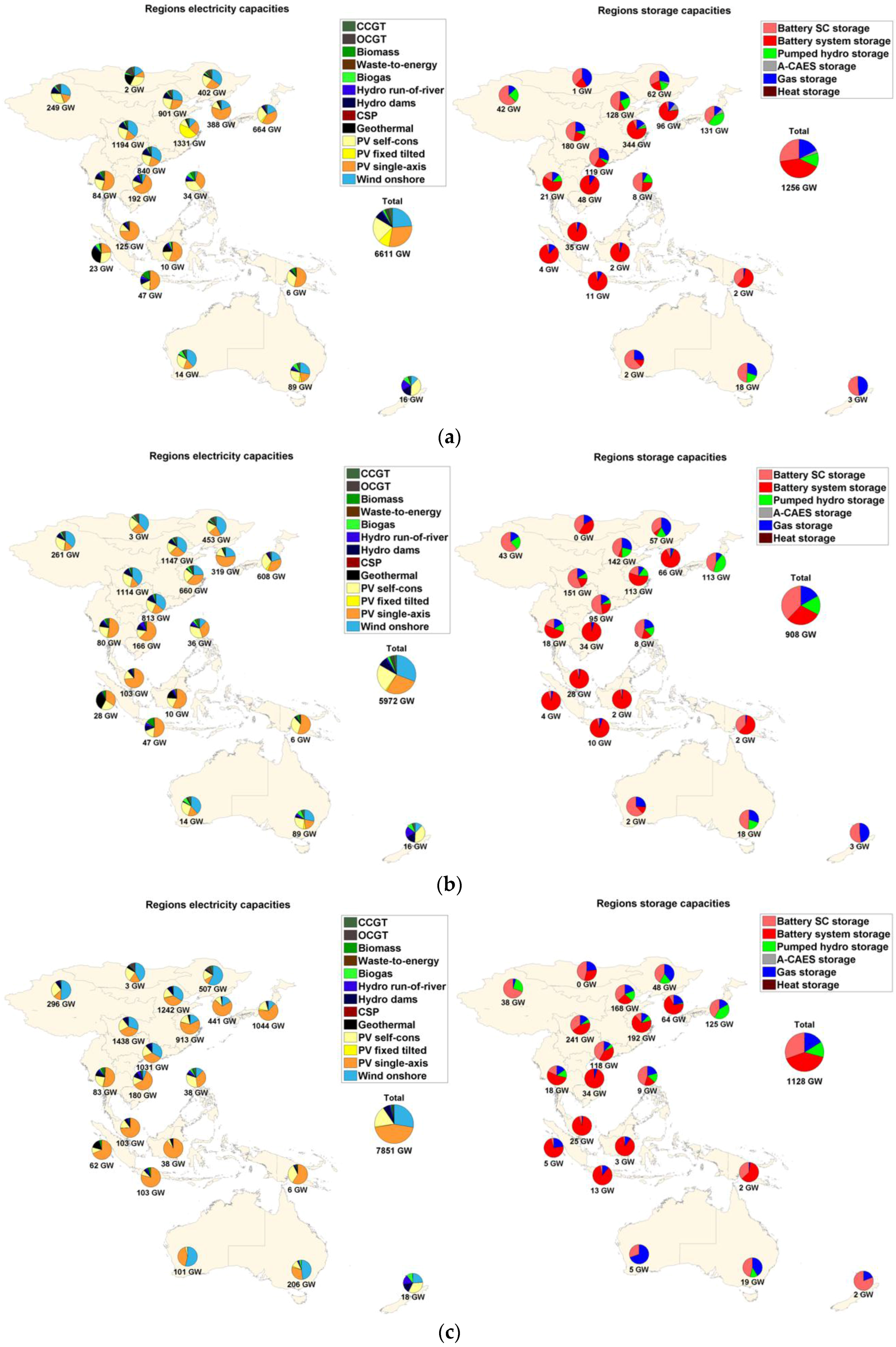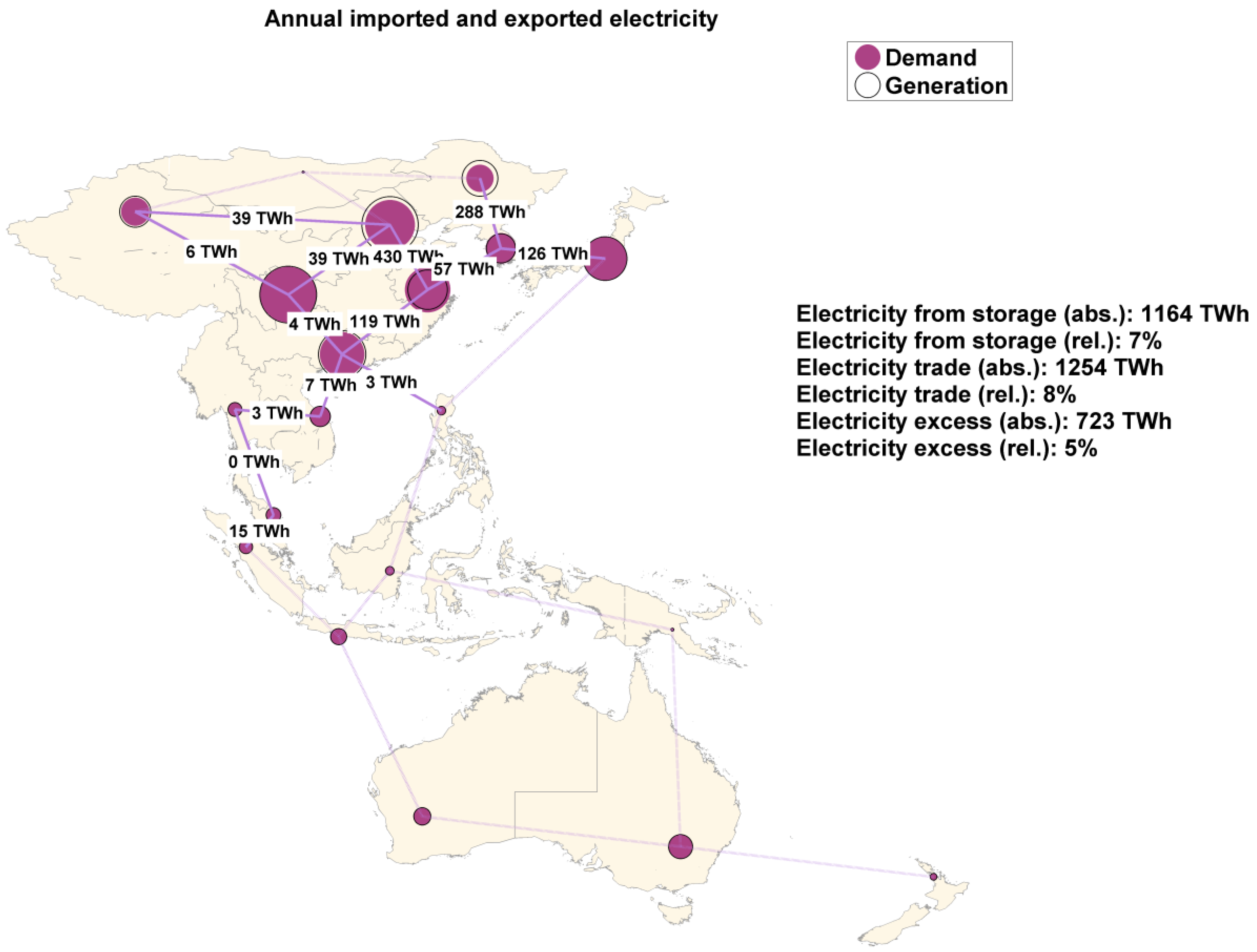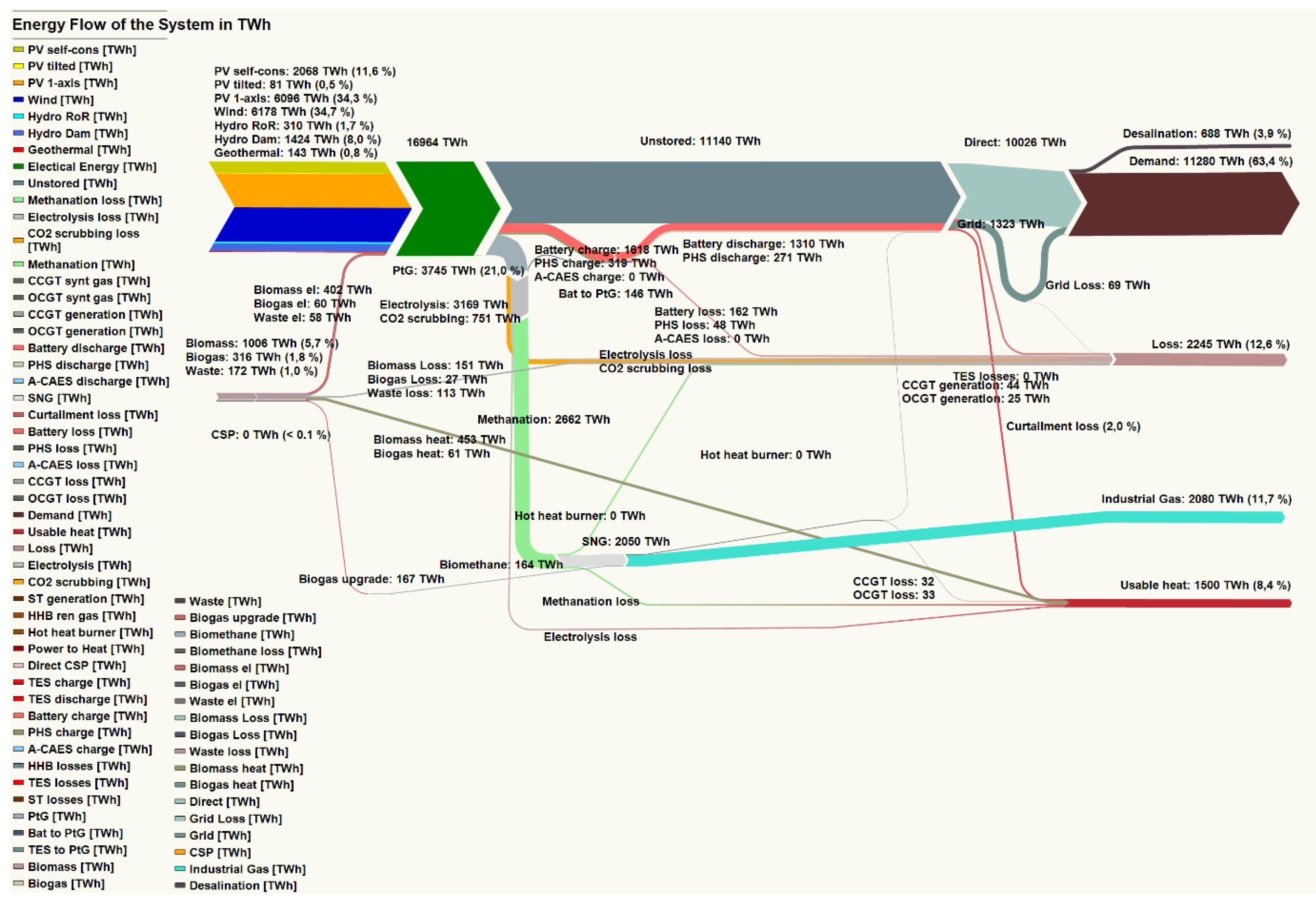1. Introduction
In December 2015, the annual Conference of Parties (COP) 21 held in Paris, also known as the Paris Agreement [
1] was an action-driven event with several concreate achievements [
2]. The conference presented several political and business leaders with the opportunity to take the critical decisions needed to keep the average global temperature rise to no more than 1.5 or 2 °C, which finally requires net zero greenhouse gas emissions shortly after the middle of this century [
1]. According to Schellnhuber et al. [
3], the 2 °C limit is economically achievable due to rapidly falling costs of renewable energy, particularly solar PV, but is constrained by politics. It is observed that change is happening in energy supply for a lot of countries, but this needs to happen faster. The region of interest for this research is East Asia, which is comprised of Northeast Asia and Southeast Asia, the latter including Australia and New Zealand.
Energy is a key driver for social and economic development, particularly in developing countries where many people have no access to basic forms of energy. Many developing countries have programs to electrify the non-electrified population and at the same time maintain a high level of economic development. Thus, the demand for electricity is growing very fast, particularly in East Asia. According to Taggart [
4], leading up to 2050, East Asia—comprised of China, Japan, the ASEAN states, and Australia—will become the world’s largest economy. To keep up with economic development and improve living conditions, there will be a rapid increase in energy needs, which will put our climate at risk, as the energy sector is one of the main sources of greenhouse gas emissions [
5]. The effects of greenhouse gas emissions will be dramatic in Southeast Asia as it is one of the most vulnerable regions and also least prepared to deal with the impacts of climate change [
5]. Coal has been the dominating fossil fuel in the energy mix of most East Asian countries [
6,
7]. Coal-fired power plants are associated with high health costs and heavy metal emissions [
8,
9,
10,
11], which are rarely taken into account in optimizing the societal cost of energy supply in a region. Therefore, in the future, East Asia will hold the key for minimizing the impacts of climate change.
The abovementioned issues account for the necessity of a fully sustainable energy system that will be mainly based on solar and wind, with other technologies complementing these two technologies. The global competitiveness of a 100% renewable-energy-based system has been discussed by Hoffman [
12]. According to Pleßmann et al. [
13], a 100% renewable energy system can mainly be developed in a decentralized manner. The discussion regarding the construction of an East Asian and Pacific supergrid has been introduced before, based on the EU-MENA Desertec vision [
14,
15] and discussed further for Northeast Asia [
16,
17]. Large-scale connectivity via the HVDC lines of different countries from Australia to China, Japan, and Korea can partially cancel out the regional intermittencies of the renewables, are easier to manage without the potential need of storage technologies, and help to transmit low emission energy across countries [
18]. For East Asia, there is not yet much research on sustainable energy transition pathways into future. The Energy [R]evolution scenario of Greenpeace [
19] proposes a pathway to 100% sustainable energy supply in the East Asian and Oceania regions, ending CO
2 emissions and phasing out nuclear energy. It also demonstrates that this transformation increases employment in the energy sector. A list of various future scenarios for East Asia with key findings is given in
Table 1. However, none of them considered the approaches applied in this study, such as an hourly-based model that guarantees that the hourly total electric energy supply in an entire year in the sub-regions covers the local demand from all sectors; different transmission grid development levels that are able to reduce the need for energy storage and total costs; and an integrated scenario that assumes electricity demand, water desalination, industrial gas demand, and a renewable energy (RE)-based synthetic natural gas (SNG) trading.
Individual major region modeling for Southeast Asia and Pacific (SEA) [
22] and Northeast Asia (NEA) [
23] has already been performed. However, the modelling of the integration of the two major regions has not yet been done before or, if presented, not all energy sectors that incorporate a spatial and temporal resolution of energy supply and demand, and that fully consider energy infrastructure or the constraints of sustainability criteria, were taken into account. For the modeling of real-world conditions, all this has to be taken into account to obtain a comprehensive low-cost energy system that will be based on 100% renewable energy. Australia is well endowed with renewable energy resources; in particular, it has immense solar resources in the center and northwest and no land constraint as Australia has one of the lowest population densities per square kilometer [
21]. Also, the rapidly falling costs of solar photovoltaic (PV) [
3,
24,
25,
26] and the high availability in Australia can help fulfill a vision of connecting Australia with ASEAN, China, and Japan via HVDC lines for a fully sustainable energy system.
This paper discusses the results of the simulation for East Asia for the year 2030 for a 100% renewable energy system. The possibility of the supply of renewable electricity, especially from solar and wind resources, with the help of HVDC power lines from Australia to ASEAN countries, China, Japan, and Korea, is touched upon and discussed. Also, there is a discussion of whether local RE-based SNG production or RE-based SNG trading between countries is more beneficial [
27]. Here a scenario with Australia as a RE-based SNG production hub composed of hybrid PV-Wind and Power-to-Gas (PtG) plants and delivering RE-based SNG to Korea and Japan is simulated and discussed. The LNG value chain (SNG liquefaction, LNG shipping, and LNG regasification) can be applied to transfer the RE-SNG generated in Australia to Asian countries. Despite the efficiency losses and additional cost of the LNG value chain, the re-gasified SNG in Asia could still be cheaper than local production to balance the power system or answer the industrial gas demand. LNG technology is already in use in Australia, Korea, and Japan, in some cases for decades [
28]. Other scenario setups are: region-wide, area-wide, and integrated scenarios. The area-wide scenario is compared with the two separated NEA and SEA regions to extract the benefit, if any, gained by the geographical energy system integration of the two individual regions.
The paper is organized as follows:
Section 2 provides the methodology, the input data, and the technologies used for the simulations.
Section 3 provides the assumptions and a description of the different scenarios used for the simulations. The results of the simulations are presented in
Section 4.
Section 5 discusses the results of the simulations. Finally, conclusions are drawn in
Section 6.
5. Discussion
It is observed that the total levelized cost of electricity in East Asia decreased by 20.2% from the region-wide to integrated scenario and the total annual cost of the system decreased by 8.3% from the region-wide to area-wide scenario. The cost incurred due to installation of HVDC lines in the area-wide scenario is overcompensated for by a decrease in installed capacities of renewable energy generation and storage, which enables a decrease of respective efficiency losses. Import of low-cost electricity from different regions also enables a decrease in curtailment of electricity. The increase in the total system cost in the integrated scenario is due to the additional demand sectors of seawater desalination and industrial gas demand, for which the system installs additional RE capacities. In the case of the integrated RE-SNG trading scenario, the total annualized cost of the system decreased by 1% from the integrated scenario. The RE-SNG value chain cost does not increase the total cost of the total area due to efficient use of available resources, a decrease in electricity imports for gas production, a decrease in the losses in the system, and a decrease in the use of gas storage in the area.
The impact of connecting different regions with HVDC power lines can be observed in the decrease in the total levelized cost of electricity. The integration of SEA and NEA does not create any substantial additional benefit to the system, since the costs are reduced by 0.4%–0.7%, depending on the scenario. The impact is limited to regions that are not far apart and where local storage technologies are more expensive than the transmission of electricity. Due to long distances and local storage technologies being more cost-competitive, low-cost RE from Australia cannot be exported to high demand centers in Indonesia and further into China due to high transmission costs. The increasing cost competitiveness of storage compared to grids had already been found for Northeast Asia [
47]. However, according to research done by Taggart et al. [
4,
18], large scale connectivity of different regions would cancel out the need for large-scale storage technologies, to which the authors of this research agree to some extent, since such an effect can be observed in the decrease in need for storage technologies from the region-wide to the area-wide scenario. Additionally, the storage demand is only reduced by 25% and not substituted entirely. According to Zenya and Blakers et al. and [
20,
21], transmission of electricity would be beneficial from Australia to China and Asia but the findings from this research contradict these expectations because they have not anticipated the low-cost potential of storage technologies against the cost of transmission of electricity from Australia to China. In addition, a full hourly resolution enables a much better matching of the various flexibility options and the complementarity of the solar and wind resources. Our findings suggest that local storage technologies are more cost-effective than transmission of electricity over distances of thousands of kilometers. A similar finding had been observed for the integration of the regions of Europe, Eurasia and MENA, for which the integration benefit was 1.3% [
48]. East Asia and EuropeEurasiaMENA show the same characteristic, that a deep integration from a region-wide to an area-wide integration within a region is highly beneficial in the range of 5%–16%, since this had been found for all five major regions involved: Northeast Asia (11%) [
23], Southeast Asia (5%) [
22], Europe (11%) [
49], Eurasia (16%) [
50], and MENA (10%) [
51]), but not for an integration of two neighboring major regions. Very long power lines between 1500 and 2000 km or more do not generate financial benefits, as found so far for Northeast Asia [
47]. Other limiting factors include an inability to integrate the vast wind resource potential of Northwest Russia for Europe [
52], utilize excellent solar and wind resources in the Maghreb region for synthetic fuel production [
53], and connect Australia to East Asia, as shown in this article. The main reason in all the above cases is the same: the costs related to the transmission of low-cost solar and wind electricity are too high compared to local energy storage for the case of very long power lines.
However, from this research the authors have found that long-distance shipping of RE-SNG is cost-effective for some regions, in this case for East China and Japan, due to low primary electricity generation costs in West Australia, the comparably low additional cost of about 17% for the LNG value chain (liquefaction, shipping and re-gasification), and the high cost of local gas production. Some regions, in this case Korea, do not benefit from such a trading connection due to favorable economics for local gas production and electricity imports from neighboring regions. As the main aim of the optimization is to minimize the total annual system cost for the entire area, the least cost system is obtained without imports to Korea and limited imports to East China and Japan.
PV technologies play an important role in the East Asian region, especially in Southeast Asia, due to good solar irradiation most of the year and PV being the least cost source of electricity in most of Southeast Asia. In Northeast Asia, wind energy plays an equally important role in periods of low solar irradiation, especially in the northern and eastern parts of China, as wind energy is the second-cheapest electricity source and is ideal for use in winter and periods of low solar radiation. According to the Advanced Energy [R]evolution transition scenario [
19] for 2030 by Greenpeace, solar PV will have the highest share of the installed capacities of renewables, with wind complementing during periods of low solar radiation. However, fossil fuels will still be present in the energy generation mix. According to this research, a 100% sustainable low-cost energy system is possible for 2030, with solar PV and wind playing a major role.
The storage requirements for East Asia are mainly based on batteries (59% of the total storage throughput), with prosumer batteries having a significant share in regions with high prosumer PV installations (41% of the total battery throughput is represented by prosumer batteries). In Southeast Asia, due to a high influence of solar PV into the system, batteries play a vital role on a daily basis, providing electricity for the evening peak load. In Northeast Asia, for regions with high wind energy penetration into the system, gas storage is used as a long-term storage, as it helps store wind energy and discharges in periods of low solar and wind energy resource availability. The output of batteries and gas storage is between 59%–78% and 7%–28% of the total stored electricity, respectively.
The integrated scenario provides the required flexibility to the system in compensating for seasonal fluctuations. In addition, it can provide the possibility of covering the natural gas demand in the industrial sector by generating synthetic natural gas by power-to-gas technology and providing clean water in water-stressed areas by SWRO desalination. The abundance of solar and wind resources in East Asia does not create any resource constraint for the additional electricity required for producing SNG and renewable water. The more flexibility can be made available for the energy system, the better intermittent RE sources can be integrated. The sources of flexibility are interconnected regions via grids, supply side management (e.g., hydro dams, biomass plants), demand side management, storage, and sector coupling. The hourly simulation for East Asia did not show unsolvable challenges to run a 100% RE system that uses all flexibility options. The applied upper limits for solar and wind resource limitation had been 4% and 6% of the total area for wind and solar energy, respectively. Utilizing both technologies in the same area would reduce the required maximum area. These limits have been utilized in the simulated scenarios by less than 30% and less than 4% for wind and solar energy, respectively. The investigated energy sectors represent about 50% of the total primary energy demand. Thus, a 100% RE system would require areas well below the set upper limits.
In addition, integrated RE-SNG trading allows the possibility of utilizing to a higher extent the abundant solar and wind potential in Australia by converting electricity to gas via the PtG process and shipping it to large industrial gas demand centers in China, Korea, and Japan. It is found that the large-scale transmission of electricity over long distances is not cost-competitive against local storage solutions. The gas imported by East China and Japan is equivalent to 65% and 74% of the total industrial gas demand, respectively. The decrease in PtG output for East China (64%) and Japan (75%) in comparison to the integrated scenario is due to importing cheaper gas from Australia rather than the local production of gas and using the electricity to meet the power demand. The gas import causes a decrease in the electricity imported to East China and Japan. The PtG output remains the same for Korea as it does not import any gas, but it imports electricity from Northeast China and produces its own gas due to favorable economics. Interestingly, not all locally produced gas is substituted by imported gas, despite the lower levelized cost of gas. This indicates a quite high gas sector integration benefit due to the high flexibility of electrolyzer units, which can be activated in hours of highest availability of low-cost resources.
The excess heat generated by the system as a byproduct of various processes such as biogas and biomass CHP plants, waste-to-energy incinerators, gas turbines, electrolyzers ,and methanation plants could be used to meet the heating demand in the industrial sector. Also, the excess electricity curtailed by the system could be converted to heat, stored in heat storage, and utilized to meet the heating demand. For the area-wide scenario the usable heat generated is 1095 TWhth per year, and for the integrated scenario it is 1500 TWhth per year. The higher usable heat in the integrated scenario is due to a higher absolute curtailment of electricity. The waste heat generated as a byproduct of biomass and biogas plants is evenly distributed over the year.
PV prosumers play a vital role in the power sector and influence the system, especially in regions where end-user electricity is higher in cost. For PV self-consumption to make an impact, its LCOE must be lower than the end-user electricity purchasing price, but it can be higher than the total system LCOE. For example, in Australia the cost of electricity is quite high, so wide-scale installation of PV on residential, commercial, and industrial rooftops can be observed here. In East Asia, PV self-consumption constitutes 18%–23% of the total generation mix depending on the scenario.
The results obtained for a 100% renewable energy based system show the available least expensive RE electricity generation option when compared to non-renewable low carbon technology options in Europe such as nuclear energy, natural gas, and coal carbon capture and storage [
54], which can only partly comply with the climate change mitigation policy for a low-carbon-based energy system. According to Agora Energiewende [
54], the LCOE of the alternatives are €112/MWh for a new nuclear plant (assumed for 2023 in the United Kingdom and Czech Republic), €112/MWh for gas CCS (assumed for 2019 in the United Kingdom, and €126/MWh for coal CCS (assumed for 2019 in the United Kingdom). A report by the European Commission [
55] indicates that CCS technology will not be available until 2030, and a report by Citigroup questions whether it will ever be profitable at all [
56]. The results obtained are lower in cost than the high-risk options, which have several disadvantages like CO
2 emissions from power plants with CCS technology, health risks due to heavy metal emissions from coal fired power plants, diminishing fossil fuel reserves, proliferation risk, nuclear meltdown, and unsolved nuclear waste disposal problems. Also, nuclear fission has limitations similar to those mentioned above. The associated financial and human research and development resources spent will not solve the energy problems in the world [
57].
6. Conclusions
In East Asia, a 100% RE-based system is achievable based on the 2030 assumptions applied in this study. The renewable energy sources can cover the electricity demand for power, SWRO desalination, RE-SNG local demand, and exports using the PtG technology. The creation of an integrated East Asian region merging SEA and NEA does not have a significant benefit in terms of the cost of electricity or the total annual cost of the system. Also, utilization of vast renewable energy resources in Australia via HVDC lines to the ASEAN countries and China seems to be non-existent due to long distances and the associated cost of transmission of electricity being higher than the cost of local storage technologies in those regions. The total LCOE of the system for East Asia is €52–61/MWh. The benefit observed by integrating NEA and SEA to East Asia is in the total annual cost of the system, which is lowered by 0.4%–0.7% depending on the scenario. The regions at the border made up of Vietnam, Laos, Cambodia, and South China benefit most due to efficient use of the available renewable energy resources and the decrease in demand for storage due to HVDC connection to high consumption centers in the southern part of China. The energy system in East Asia will be based on around 50% PV and 30% wind given the assumptions of this study. PV is mainly dominant in SEA due to favorable climatic conditions and wind plays a vital part in NEA.
However, production of RE-SNG from the available electricity in West Australia and exporting it to high-demand centers seems to be beneficial for East China and Japan. The cost of electricity and the total annual cost of the system are lowest for the integrated RE-SNG trading scenario among the four scenarios studied. This proves that Australia could become a hub for liquefaction of RE-based SNG by utilizing the abundant solar and wind potential. However, more such cases need to be analyzed around the world for better understanding of RE-SNG trading scenarios. It has been not fully resolved why it does not seem to be beneficial for Korea to import RE-SNG despite a comparably higher local SNG production cost than Japan and East China. However, the sectorial integration benefit of the gas sector seems to be higher in Korea. In addition, neither Japan nor East China has shown the full local SNG production substituted, despite a higher absolute local SNG production cost, most likely due to the high value of gas sector integration.
A 100% renewable energy system for East Asia seems to be highly attractive, in particular due to the fact that it costs less than the subsidies for a coal-based energy system. It also offers a fully sustainable option complying with the climate change mitigation targets.
